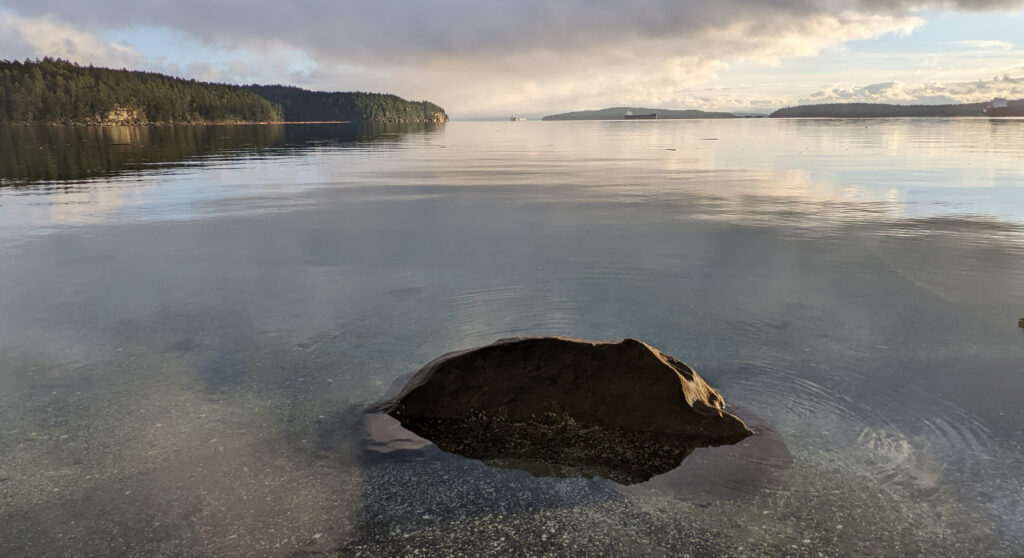This judicial review concerned a large commercial and residential development called Sen̓áḵw (the “Development”) on Kitsilano Reserve No. 6 (the “Kitsilano Reserve”), located along the southern shores of False Creek and around the Burrard Bridge in Vancouver, BC. The court applied the United Nations Declaration on the Rights of Indigenous Peoples (“UN Declaration”) and the provincial Declaration on the Rights of Indigenous Peoples Act (“Declaration Act”) to determine whether the City of Vancouver (“City”) reasonably interpreted and exercised its powers under the Vancouver Charter in relation to the Development.

Photo credit: Doane Gregory
Background
The court described the Development as being located on the site of a village where sḵwx̱wú7mesh (Squamish) people would engage in trade activities with neighbouring xʷməθkʷəy̓əm (Musqueam) and səl̓ilwətaɬ (Tsleil-Waututh) peoples. Sometime before 1867, the BC colonial government established the Kitsilano Reserve. In 1877, Canada enlarged it to include approximately 80 acres, but in 1886, the Canadian Pacific Railway expropriated part of the land to construct a rail line, which resulted in the taking of a 10.5 acre “T” shaped parcel.
In 1913, the provincial government illegally induced sḵwx̱wú7mesh to leave the Kitsilano Reserve, and by 1946, the Kitsilano Reserve had been completely dismantled.
In 1977, Squamish Nation successfully sued Canada for the mismanagement of the Kitsilano Reserve and received in return the 10.5-acre parcel, which by then was no longer used for railway purposes. xʷməθkʷəy̓əm and səl̓ilwətaɬ then launched a claim against Canada for failing to protect their interests when allocating the Kitsilano Reserve to sḵwx̱wú7mesh, and settled their claim for $92.5 million.
In 2019, via referendum, sḵwx̱wú7mesh members approved the Development, which is to include 11 towers reaching heights of 56 stories, consisting of approximately 6,000 residential rental units, as well as commercial space and community amenities. Twenty percent of the rental units are to be affordable housing.

Photo credit: Doane Gregory
Issues
The Kits Point Residents Association (the “Association”) opposed the scale of the project and ‘secrecy’ surrounding related municipal decisions. The Association argued that a city council resolution passed in camera in July 2021 (the “Resolution”), authorizing the City to enter into a municipal services agreement with Squamish Nation to facilitate the Development (“Services Agreement”), contravened the Vancouver Charter. The Association also argued the City breached procedural fairness, acted in bad faith throughout the process, and made an unreasonable decision to approve the Services Agreement.
Analysis
The court determined the correctness standard of review applied to procedural fairness, while reasonableness applied to the City’s decisions approving the Services Agreement because the question is fundamentally about whether decision makers acted reasonably within scope of their legal authority. The court also noted the Declaration Act provides context for interpreting the Vancouver Charter but is not determinative of the issue.1
The Vancouver Charter Provisions allowing the Resolution were Interpreted Lawfully
The court determined that the City’s interpretation of Sections 165.1, 165.2, and 165.3 of the Vancouver Charter was reasonable. Section 165.1 requires city council meetings to be open to the public, but for enumerated subject matter under s 165.2, including “(e) the acquisition, disposition or expropriation of land or improvements” and “(k) negotiations and discussions respecting an activity in their preliminary stages, that if disclosed publicly, could reasonably be expected to harm the interests of the city.” (Emphasis added.) Section 165.3 requires that resolutions for closed door meetings be approved in a public meeting and be based on a reason under section 165.2.2
The court applied the modern principle of statutory interpretation, section 8 of the federal Interpretation Act, section 8.1(2) of the provincial Interpretation Act, the Nowegijick principle, and the UN Declaration (Articles 3, 4, 5, and 23) to guide its interpretation of these sections. Citing Gitxaala, the court held the Declaration Act is an “overlay” that requires statutes to be interpreted consistently with the UN Declaration.3
On this basis, the court found that the section 165.2(k) reference to “interests of the city” does not mean only Vancouver residents and communities. Rather, the City rightly appreciated the historical and legal context of the Development and interpreted the “interests of the city” consistently with the UN Declaration and the Declaration Act.4 The City was reasonable in finding that it does not have the ability to regulate or control developments on reserve lands.5 The court also noted that there could have been “harm” to the City had it fully disclosed its positions to the public while in the midst of lengthy and complex negotiations with Squamish Nation.6
Procedural Fairness and Legitimate Expectations did not apply
The court considered the Baker factors for procedural fairness in a municipal decision-making context. Case law confirms that bylaws of a general legislative nature do not attract procedural fairness, but bylaws of a specific nature do. Likewise, the court found no procedural fairness was owed to the Association or the general public in relation to the Services Agreement, because the in camera Resolution and the Services Agreement did not impact property rights, privileges or interests of any one individual.7 While the Services Agreement was of significant interest to the Association and Vancouver residents, the City was not required to balance their rights and interests in a manner that would make it a quasi-judicial decision attracting procedural fairness obligations.8 Further, municipalities, including the City, do not need to engage the public before entering into commercial agreements or when exercising its business powers.9
The court rejected the Association’s argument of legitimate expectations. As per CUPE v Ontario (Minister of Labour), legitimate expectations can only arise when a promise is not in conflict with a statutory power.10 Here, the City’s decisions were clearly authorized by legislative authority. Furthermore, the City did not make any promises to hold public consultations. In fact, the City was clear that no consultation would take place regarding the Services Agreement.11 Ultimately, the City decided to facilitate the Development, rather than use procedural steps to impede or influence it.12
The City had legal authority to enter into the Services Agreement
Sections 145, 192.1, and 192 of the Vancouver Charter and section 37 of the Indian Self Government Enabling Act (“ISGEA”) enumerate the relevant powers of the City in this circumstance. Section 145(2) states the City “has full power to engage in any commercial, industrial or business undertaking.” (Emphasis added.) Section 192.1 allows the City to join with another municipality to exercise power permitted under the Vancouver Charter, and section 192 allows the City to enter into agreements with municipalities that the council deems “for the benefit of the city” so long as an enabling provincial or federal law contemplates such an agreement.13 Furthermore, the ISGEA allows “a Provincial taxing authority” (e.g., the City) to enter into service agreements with a Band in so far as the City is allowed to provide those services under “its usual mandate.”14
The court found the City reasonably interpreted its powers.15 The Services Agreement reflects the intent of the ISGEA, which is to allow First Nation governments that have established requisite taxation laws to enter into a service agreements with municipalities for the provision of local services.16 Furthermore, the court held that section 192 of the Vancouver Charter allows the City to enter agreements to provide basic services and it is for city council to determine what is “for the benefit of the city.”17
No Evidence of Bad Faith
Bad faith encompasses a wide range of conduct, such as fraud, bias, conflicts of interest, discrimination, abuse of power, and corruption.18 The Applicants alleged that the City acted in bad faith by conducting a non-transparent process, claiming that it had no power to influence the Development, and giving rise a false public impression that there would be some sort of meaningful public engagement.19 The court found no evidence to ground these allegations, including in relation to the in camera Resolution. Rather, the City acted reasonably to protect its interests by not disclosing the Resolution publicly and concluding it would not use negotiations to influence the density of the Development.20
The City did not Fetter its Discretion
‘Fettering of discretion’ means decision makers cannot limit the statutory powers that they are required to exercise by adopting a policy and refusing to consider factors that are legally relevant to a decision.21 The Applicants argued that section 184 of the Vancouver Charter required the City to submit questions related to the Development to Vancouver electors, because Council may submit a referendum question with which it “has or desires to have the power to deal.” The Association alleged the City should have had a desire to influence the Development, and this should have prompted a referendum. Furthermore, by adopting its “Guiding Principles” that informed negotiations with Squamish Nation, the Association argued that the City fettered its power to negotiate the scale of the Development.
The court found the Guiding Principles did not mean City fettered its discretion. In this case, the City was not the only available service provider. Squamish Nation could have received services from Metro Vancouver or provided their own services had the City refused to negotiate or attempted to influence the Development.22 Furthermore, the City was deferential out of respect for Squamish Nation’s authority to develop their lands and rejected the option to use the Services Agreement as a bargaining chip to constrain the Development. This approach was consistent with the City’s goal of becoming a “City of Reconciliation.”23 Also, the City did not blindly follow Squamish Nation’s preferences. For example, the City publicly disclosed the Services Agreement eventually, despite Squamish Nation’s preference for it to remain confidential.24
Key Takeaways
This case reaffirms key principles of statutory interpretation, administrative law, and municipal law within the context of Indigenous and municipal governments. One lesson is that municipal governments do not owe procedural fairness to the public when making general legislative decisions. While public hearings and disclosure may be preferable or beneficial for political reasons, municipal governments do not need to follow a process beyond what the relevant statutes or by-laws require, unless they are of a specific nature. Furthermore, the court accounted for the legal and historical context of the Development in determining the City reasonably interpreted and applied its decision-making powers authorized under the Vancouver Charter. This approach is consistent with the Declaration Act’s requirement for statutes to be construed in a manner that advances the UN Declaration, including Indigenous rights to self-determination and self-government.
This case summary provides our general comments on the case discussed and should not be relied on as legal advice. If you have any questions about this case or any similar issue, please contact any of our lawyers.
See CanLII for the Reasons for Judgement.
Footnotes
1 Kits Point Residents Association v Vancouver
2023 BCSC 1706, Para 127.
2 Para 166.
3 Paras 167-172; see also Gitxaala v BC (Chief Gold Commissioner) at para 418.
4 Para 182.
5 Para 183.
6 Paras 185-190.
7 Para 202.
8 Para 203.
9 Para 205.
10 Para 207; 2003 SCC 29 at para 131.
11 Para 209.
12 Para 211.
13 Para 213.
14 Para 214.
15 Para 225.
16 Paras 226-227.
17 Paras 228-230.
18 Para 231.
19 Para 234.
20 Paras 237-240.
21 Para 244; Halfway River First Nation v BC (Ministry of Forests), 1999 BCCA 470.
22 Para 245.
23 Para 247.
24 Para 249.